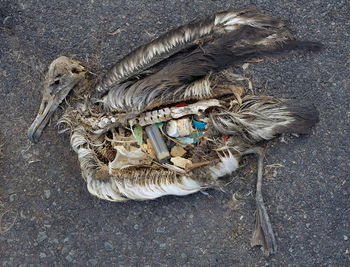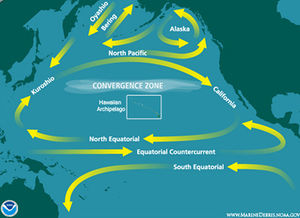Difference between revisions of "Plastic in the Ocean"
Dronkers J (talk | contribs) |
|||
| Line 1: | Line 1: | ||
| − | {{ | + | {{Incomplete}} |
| + | |||
| + | Extension and update needed. | ||
| + | |||
== Introduction == | == Introduction == | ||
| Line 55: | Line 58: | ||
==See also== | ==See also== | ||
| − | * | + | *https://en.wikipedia.org/wiki/Marine_debris |
| − | * http:// | + | *https://en.wikipedia.org/wiki/Microplastics |
| − | * | + | *http://ec.europa.eu/environment/waste/plastic_waste.htm |
| + | *http://ec.europa.eu/environment/marine/good-environmental-status/descriptor-10/index_en.htm | ||
| + | |||
Revision as of 15:11, 2 October 2018

|
Extension and update needed.
Contents
Introduction
Marine debris is found in all seas areas of the world – not only in densely populated regions, but also in remote places far away from any obvious sources. Marine litter originates from many sea-based and land-based sources and causes a wide spectrum of environmental, economic, safety, health and cultural impacts. The very slow rate of degradation of most marine litter items, mainly plastics, together with the continuously growing quantity of the litter and debris disposed, is leading to a gradual, but dramatic increase in the quantities of marine litter in our oceans and world shores.[1] The majority of marine debris is composed by or originated from plastic litter, such as plastic bags and containers, bottle caps, lost or abandonned fishing nets and lines, styrofoam or small plastic pellets.
Where does it come from?
Though 20% of the marine debris has its origin from ocean sources like derelict fishing gear or ocean dumping, 80% comes from land-based activities, through wind-blown landifll waste or rivers.
Impacts
Lost and discarded fishing gear is a primary cause for environmental, economic and public safety concern, but plastics are far the most pervasive of marine litter items[1].
Aesthetics
Marine debris is an eyesore along shorelines around the world. It degrades the beauty of the coastal environment and in many cases may cause economic loss if an area is a popular tourist destination.
Habitat Damage
Marine debris can scour, break, smother, and otherwise damage important marine habitat, such as coral reefs. Many of these habitats serve as the basis of marine ecosystems and thus they are critical to the survival of many other species.
Ghostfishing
Ghostfishing, mainly by derelict fishing gear (e.g. nets) is a problem in many areas around the world. This is when a derelict gear item continues to fish though lost or discarded. The scope of this particular impact to commercially important species and others is not well known.
Wildlife Entanglement
One of the most notable types of impacts from marine debris is wildlife entanglement. Numerous marine animals become entangled in marine debris each year. Entanglement can lead to injury, illness, suffocation, starvation, and death.
Ingestion
Many animals, such as sea turtles, seabirds, and marine mammals have been known to ingest marine debris, which they mistake for food. This may lead to loss of nutrition, internal injury, intestinal blockage, starvation, and even death. One study found that 82 of 144 bird species examined contained small plastic debris in their stomachs, and in many species the incidence of ingestion exceeds 80% of the individuals[2]).
Marine debris can be difficult to see in the ocean and can also be quite large. Because of this it is a navigational hazard to vessels. Encounters with marine debris at sea can result in costly damage to a vessel such as a tangled propeller or clogged intake.
Alien Species Transport
Any floating or drifting material that may serve as substrate can be a potential vector or transport mechanism for non-native species.
Economic Impact
The impacts of marine debris to our marine resources, tourism, vessels and navigation, ecosystems, and human health and safety are difficult to quantify, but they all have a cost.
Human Health
Plastics are synthesized material that can release or degrade into harmful substances to which humans can directly (e.g. through the water) or indirectly (e.g. through the food web) be exposed.
What is the dimension of the problem?
The plastic dominates the marine debris not only due to its intensive production and extensive use in the last decades but also because it is not biodegradable. Therefore, it can remain in the oceans for a long time and travel long distances through marine currents, accumulating along the shores or converging ocean zones. A conspicuous example of the latter is found in the central North Pacific Ocean, known as the Pacific trash vortex[3], where the pieces of plastic outweigh surface plankton by a factor of 6 to 1 [2].
See also
- https://en.wikipedia.org/wiki/Marine_debris
- https://en.wikipedia.org/wiki/Microplastics
- http://ec.europa.eu/environment/waste/plastic_waste.htm
- http://ec.europa.eu/environment/marine/good-environmental-status/descriptor-10/index_en.htm
References
- ↑ 1.0 1.1 1.2 UNEP/IOC Guidelines on survey and monitoring of marine litter, 2009.
- ↑ 2.0 2.1 Moore, C., Moore, S., Leecaster, M. & Weisberg, S., 2001. A comparison of plastic and plankton in the North Pacific central gyre. Marine Pollution Bulletin 42, 1297–1300.
- ↑ http://marinedebris.noaa.gov/info/patch.html
Please note that others may also have edited the contents of this article.
|

